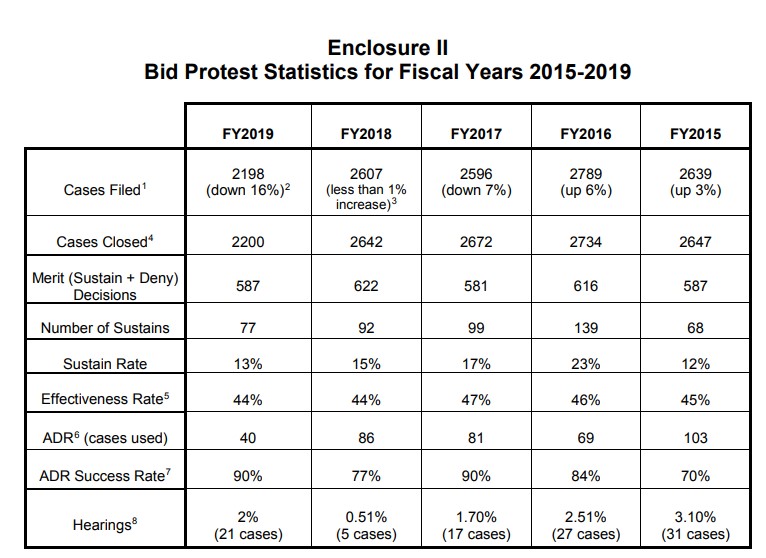GAO recently issued its annual report to Congress, which provides data concerning protest filings for Fiscal Year (FY) 2019.[1] GAO’s annual report confirms a sharp decrease in the number of protests filed. Notably, 2,198 protests were filed in FY 2019—a 16% decrease from FY 2018.
The report does not identify a reason for the decrease, but one driver may be the jurisdictional limits on protesting task orders. Initiatives like Category Management have led to more and more requirements being procured as task orders. According to the report, 373 of the protests that were closed in FY 2019 were protests of task orders under indefinite-delivery/indefinite-quantity contracts. This is a small number of protests given the number of task orders awarded. In the National Defense Authorization Act for FY 2017, Congress reinstated GAO’s jurisdiction over task order protests and increased the threshold to protest a task order issued by a Department of Defense agency to $25 million. (The threshold to protest a task order issued by a civilian agency is $10 million.) Task orders that do not meet the jurisdictional thresholds cannot be protested at GAO, which may explain some or all of the decrease in FY 2019. The jurisdictional limit likely has a significant impact on small businesses, which are often the recipients of task orders that do not meet the dollar thresholds.
Of the protests GAO received in FY 2019, it reached a decision on the merits in 587 cases, and of those, 77 were sustained, for a sustain rate of 13%. This is a slight decrease from the 15% sustain rate in FY 2018. According to GAO, the most prevalent grounds for sustaining protests during FY 2019 were: (1) unreasonable technical evaluation; (2) inadequate documentation of the record; (3) flawed selection decision; (4) unequal treatment; and (5) unreasonable cost or price evaluation.
When GAO does not reach a decision on the merits, the case is resolved earlier in the process, often through voluntary corrective action. Overall, the effectiveness rate of protests in FY 2019 was 44%, reflecting instances where a protester received some form of relief, either through corrective action or a decision on the merits. This rate was consistent with the effectiveness rate in FY 2018, and it has not varied significantly over the last five years.
It is difficult to make predictions based on this year’s report. FY 2019 could prove to be an outlier, and the number of protests filed may bounce back next year. Or, the decrease to 2,198 protests filed could be a new normal. The number of cases filed has fluctuated by as much as seven percent in recent years. When considering whether to protest, disappointed offerors should be on the lookout for indications that there were errors in the technical evaluation, cost/price evaluation, or source selection decision—including insufficient documentation or unequal treatment. Although the likelihood of success on the merits may not be high given the sustain rate, agencies often take corrective action to avoid defending against a protest. Those types of issues in the procurement file may cause the agency to take corrective action.
If you are interested in filing a pre-award protest or do not receive an award and want to know what your options for protest are, you should immediately contact legal counsel to make sure you timely assert your rights. If you have questions about bid protests or other concerns related to government contracting, please contact a member of PilieroMazza’s Government Contracts Group.
Michelle Litteken, the author of this blog, is Counsel in the Firm’s Government Contracts Claims and Appeals, Government Contracts, False Claims Act, and Litigation & Dispute Resolution practice groups.



